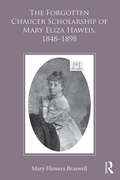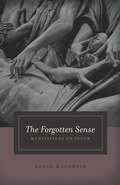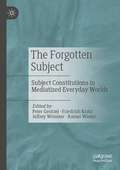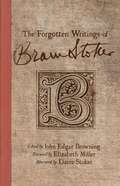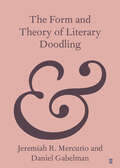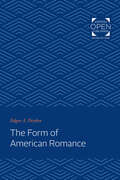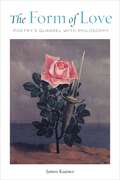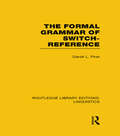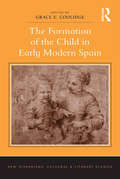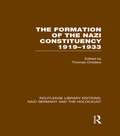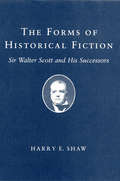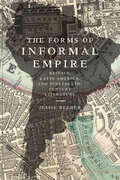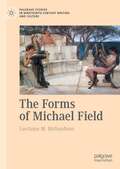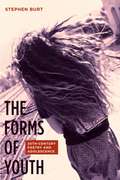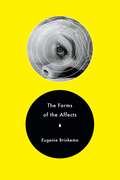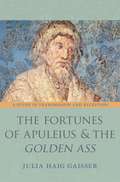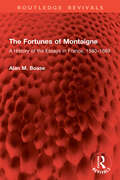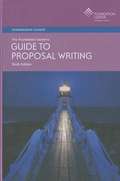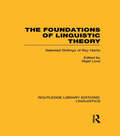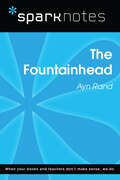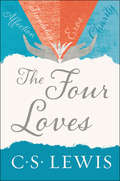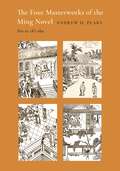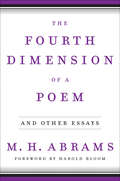- Table View
- List View
The Forgotten Chaucer Scholarship of Mary Eliza Haweis, 1848–1898
by Mary Flowers BraswellThe author of numerous books on Geoffrey Chaucer, the nineteenth-century scholar, Mary Eliza Haweis, has been largely erased from general histories of Chaucer studies. In her critical biography, Mary Flowers Braswell traces Haweis’s career, bringing her out of obscurity and placing her contributions to Chaucer scholarship in the context of those of influential Chaucerians of the period such as Frederick James Furnivall, Walford Dakin Selby, and Walter Rye. Braswell draws on extensive archival research from a broad range of late-Victorian newspapers, journals, and society papers to weave a fascinating picture of Haweis’s own life and work, which in quantity and quality rivaled that of her contemporaries. Haweis, we discover, corrected assumptions related to the Chaucer seal and texts, bringing her findings to the attention of the public in works such as Chaucer for Schools, the first textbook on the poet. Braswell also sheds light on the ways in which fashion, society, culture, art, and leisure activities intermingled with scholarship, archival recovery, museum work, editing, writing, and publishing in the late-Victorian middle and upper classes. Concluding with a discussion of Haweis’s forgotten role as head of the Chaucer section for the National Home Reading Union, Braswell’s book makes a strong case both for Haweis’s influence as a Chaucer scholar and her importance as an educator in nineteenth-century Britain and the United States.
The Forgotten Sense: Meditations on Touch
by Pablo MauretteOf all the senses, touch is the most ineffable—and the most neglected in Western culture, all but ignored by philosophers and artists over millennia. Yet it is also the sense that links us most intimately to the world around us, from our mother’s caress when we’re born to the gentle lowering of our eyelids after death. The Forgotten Sense gives touch its due, addressing it in multifarious ways through a series of six essays. Literary in feel, ambitious in conception, admirable in their range of reference and insight, these meditations address questions fundamental to the understanding of touch: What do we mean when we say that an artwork touches us? How does language affect our understanding of touch? Is the skin the deepest part of the human body? Can we philosophize about a kiss? To aid him in answering these questions, Pablo Maurette recruits an impressive roster of cultural figures from throughout history: Homer, Lucretius, Chrétien de Troyes, Melville, Sir Thomas Browne, Knausgaard, Michel Henry and many others help him unfurl the underestimated importance of the sense of touch and tactile experience. The resulting book is essay writing at its best—exploratory, surprising, dazzling, a reading experience like no other. You will come away from it with a new appreciation of touch, and a new way of understanding our interactions with the world around us.
The Forgotten Subject: Subject Constitutions in Mediatized Everyday Worlds
by Jeffrey Wimmer Friedrich Krotz Rainer Winter Peter GentzelThe volume provides a critical inventory of existing concepts of the subject in communication studies research. In addition, concepts are developed in order to be able to analyze subjectivity in the context of current theoretical debates (including media sociology, cultural studies, psychoanalysis, practice theory, science and technology studies) as well as social, cultural and technical developments (including digitalization, mediatization, mobility and networking). Since subject conceptions are of central importance for any communication and media analyses, the volume fills a central gap in communication and media studies.
The Forgotten Writings Of Bram Stoker
by John Edgar BrowningPresented here, for the first time since their publication over a century ago, are twelve previously unknown published works of fiction, poetry, and journalistic writing by Bram Stoker (1847-1912), three works never before reprinted, twelve period writings about Stoker, and the rare 1913 estate sale catalogue of his personal library.
The Form and Theory of Literary Doodling (Elements in Publishing and Book Culture)
by Jeremiah R. Mercurio Daniel GabelmanThis Element investigates the phenomenon of literary doodling—the making of playful verbal and visual creations by professional authors while engaged in another activity. The first part focuses on defining the form and structure of doodles, comparing and contrasting them with adjacent genres such as sketches, caricatures, and illustrations. The second part explores the modality of doodling, examining doodles through the lenses of spectrality, liminality, and play. Drawing on a wide range of theories and backed up with numerous close readings, the Element argues that doodles, despite their apparent triviality, provide valuable insights into the creative processes, authorial habits, and finished works of literary doodlers. Ultimately, this study aims to legitimise doodles as worthy of serious critical attention, demonstrating how they trouble the meaning of texts, introduce semantic flexibility into literary works and their reception, and rejuvenate the joy of readerly discovery.
The Form of American Romance
by Edgar DrydenOriginally published in 1988. Edgar Dryden challenges recent criticism that has tended to discredit—or at least devalue—the importance of "romance" as a thematic and generic category of American fiction. In The Form of American Romance, he examines its evolution and meaning through readings of five exemplary texts: Hawthorne's Marble Faun, Melville's Pierre, James's Portrait of a Lady, Faulkner's Absalom, Absalom!, and Barth's Letters. Each of these novels treats the problems of reading and writing in a self-referential way that reflects on the questions they dramatize, and Dryden has chosen each with the others in mind. Taken together, they chart a line of development with representative examples of what literary history calls romanticism, realism, modernism, and postmodernism, and thus they suggest a certain story about the continuity of the American novel.
The Form of Love: Poetry’s Quarrel with Philosophy
by James KuznerCan poetry articulate something about love that philosophy cannot? The Form of Love argues that it can. In close readings of seven “metaphysical” poems, the book shows how poets of the early modern period and beyond use poetic form to turn philosophy to other ends, in order not to represent the truth about love but to create a virtual experience of love, in all its guises. The Form of Love shows how verse creates love that can’t exist without poetry’s specific affordances, and how poems can, in their impossibility, prompt love’s radical re-imagining. Like the philosophies on which they draw, metaphysical poems imagine love as an intense form of non-sovereignty, of giving up control. They even imagine love as a liberating bondage—to a friend, a beloved, a saint, a God, or a garden. Yet these poems create strange, striking versions of such love, made in, rather than through, the devices, structures, and forces where love appears.Tracing how poems think, Kuzner argues, requires an intimate form of reading: close—even too close—attention to and thinking with the text. Showing how poetry thinks of love otherwise than other fields, the book reveals how poetry and philosophy can nevertheless enter into a relation that is itself like love.
The Formal Grammar of Switch-Reference (Routledge Library Editions: Linguistics)
by Daniel L FinerThis book studies the syntax of switch-reference and its implications for the theory of grammar. Switch-reference, found in many genetically and geographically diverse languages, is a phenomenon whereby referential identity between subjects of hierarchically adjacent clauses is encoded by the presence of a morpheme, usually suffixed to the verb of the subordinate clause. This book argues that switch-reference should be analysed as a syntactic rather than a purely pragmatic or functional feature of language.
The Formation of the Child in Early Modern Spain (New Hispanisms: Cultural and Literary Studies)
by Grace E. CoolidgeDrawing on history, literature, and art to explore childhood in early modern Spain, the contributors to this collection argue that early modern Spaniards conceptualized childhood as a distinct and discrete stage in life which necessitated special care and concern. The volume contrasts the didactic use of art and literature with historical accounts of actual children, and analyzes children in a wide range of contexts including the royal court, the noble family, and orphanages. The volume explores several interrelated questions that challenge both scholars of Spain and scholars specializing in childhood. How did early modern Spaniards perceive childhood? In what framework (literary, artistic) did they think about their children, and how did they visualize those children’s roles within the family and society? How do gender and literary genres intersect with this concept of childhood? How did ideas about childhood shape parenting, parents, and adult life in early modern Spain? How did theories about children and childhood interact with the actual experiences of children and their parents? The group of international scholars contributing to this book have developed a variety of creative, interdisciplinary approaches to uncover children’s lives, the role of children within the larger family, adult perceptions of childhood, images of children and childhood in art and literature, and the ways in which children and childhood were vulnerable and in need of protection. Studying children uncovers previously hidden aspects of Spanish history and allows the contributors to analyze the ideals and goals of Spanish culture, the inner dynamics of the Habsburg court, and the vulnerabilities and weaknesses that Spanish society fought to overcome.
The Formation of the Nazi Constituency 1919-1933 (Routledge Library Editions: Nazi Germany and the Holocaust)
by Thomas ChildersIn the years preceding publication of this book in 1986 much progress was made in identifying the social sources of support for Hitler’s NSDAP and in determining the tactics employed by the party to mobilise its constituency at grass roots level. It has emerged that the Nazi’s roots were far more diverse than previously assumed, extending beyond the lower middle class to encompass both the affluent bourgeoisie and the working class. This book collects together original studies which represent a distillation of some of the contemporaneous research.
The Formation of the Victorian Literary Profession
by Richard SalmonRichard Salmon provides an original account of the formation of the literary profession during the late Romantic and early Victorian periods. Focusing on the representation of authors in narrative and iconographic texts, including novels, biographies, sketches and portrait galleries, Salmon traces the emergence of authorship as a new form of professional identity from the 1820s to the 1850s. Many first-generation Victorian writers, including Carlyle, Dickens, Thackeray, Martineau and Barrett-Browning, contributed to contemporary debates on the 'Dignity of Literature', professional heroism, and the cultural visibility of the 'man of letters'. This study combines a broad mapping of the early Victorian literary field with detailed readings of major texts. The book argues that the key model of professional development within this period is embodied in the narrative form of literary apprenticeship, which inspired such celebrated works as David Copperfield and Aurora Leigh, and that its formative process is the 'disenchantment of the author'.
The Forms of Historical Fiction: Sir Walter Scott and His Successors
by Harry E. ShawHarry Shaw’s aim is to promote a fuller understanding of nineteenth-century historical fiction by revealing its formal possibilities and limitations. His wide-ranging book establishes a typology of the ways in which history was used in prose fiction during the nineteenth century, examining major works by Sir Walter Scott—the first modern historical novelist—and by Balzac, Hugo, Anatole France, Eliot, Thackeray, Dickens, and Tolstoy.
The Forms of Informal Empire: Britain, Latin America, and Nineteenth-Century Literature
by Jessie ReederAn ambitious comparative study of British and Latin American literature produced across a century of economic colonization.Spanish colonization of Latin America came to an end in the early nineteenth century as, one by one, countries from Bolivia to Chile declared their independence. But soon another empire exerted control over the region through markets and trade dealings—Britain. Merchants, developers, and politicians seized on the opportunity to bring the newly independent nations under the sway of British financial power, subjecting them to an informal empire that lasted into the twentieth century. In The Forms of Informal Empire, Jessie Reeder reveals that this economic imperial control was founded on an audacious conceptual paradox: that Latin America should simultaneously be both free and unfree. As a result, two of the most important narrative tropes of empire—progress and family—grew strained under the contradictory logic of an informal empire. By reading a variety of texts in English and Spanish—including Simón Bolívar's letters and essays, poetry by Anna Laetitia Barbauld, and novels by Anthony Trollope and Vicente Fidel López—Reeder challenges the conventional wisdom that informal empire was simply an extension of Britain's vast formal empire. In her compelling formalist account of the structures of imperial thought, informal empire emerges as a divergent, intractable concept throughout the nineteenth-century Atlantic world.The Forms of Informal Empire goes where previous studies of informal empire and the British nineteenth century have not, offering nuanced and often surprising close readings of British and Latin American texts in their original languages. Reeder's comparative approach provides a new vision of imperial power and makes a forceful case for expanding the archive of British literary studies.
The Forms of Michael Field (Palgrave Studies in Nineteenth-Century Writing and Culture)
by LeeAnne M. RichardsonMichael Field, the poetic identity created by Katharine Bradley (1846-1914) and her niece Edith Cooper (1862-1913), ceaselessly experimented with forms of identity and forms of literary expression. The Forms of Michael Field argues that their modes of self-creation are analogous to their poetic creations, and that exploring them in tandem is the best way to understand Michael Field’s cultural and literary importance. Michael Field deploys a different form in each volume of their lyric poetry: translations of Sappho, ekphrasis, songs, sonnets, and devotional verse. They also appropriate and revise the dramatic genres of verse tragedy and the masque. Each of these experiments in form enable Michael Field to differently address the cultural questions that beset late-Victorian women writers. Drawing on the insights of new lyric studies and new formalism, this book analyzes Michael Field’s continual quest for the aesthetic forms that best express their evolving ideas about identity and sexuality, gender and sacrifice, lyric voice and authority.
The Forms of Youth: Twentieth-Century Poetry and Adolescence
by Stephanie BurtEarly in the twentieth century, Americans and other English-speaking nations began to regard adolescence as a separate phase of life. Associated with uncertainty, inwardness, instability, and sexual energy, adolescence acquired its own tastes, habits, subcultures, slang, economic interests, and art forms. This new idea of adolescence became the driving force behind some of the modern era's most original poetry.Stephen Burt demonstrates how adolescence supplied the inspiration, and at times the formal principles, on which many twentieth-century poets founded their works. William Carlos Williams and his contemporaries fashioned their American verse in response to the idealization of new kinds of youth in the 1910s and 1920s. W. H. Auden's early work, Philip Larkin's verse, Thom Gunn's transatlantic poetry, and Basil Bunting's late-modernist masterpiece, Briggflatts, all track the development of adolescence in Britain as it moved from the private space of elite schools to the urban public space of sixties subcultures. The diversity of American poetry from the Second World War to the end of the sixties illuminates poets' reactions to the idea that teenagers, juvenile delinquents, hippies, and student radicals might, for better or worse, transform the nation. George Oppen, Gwendolyn Brooks, and Robert Lowell in particular built and rebuilt their sixties styles in reaction to changing concepts of youth. Contemporary poets continue to fashion new ideas of youth. Laura Kasischke and Jorie Graham focus on the discoveries of a specifically female adolescence. The Irish poet Paul Muldoon and the Australian poet John Tranter use teenage perspectives to represent a postmodernist uncertainty. Other poets have rejected traditional and modern ideas of adolescence, preferring instead to view this age as a reflection of the uncertainties and restricted tastes of the way we live now. The first comprehensive study of adolescence in twentieth-century poetry, The Forms of Youth recasts the history of how English-speaking cultures began to view this phase of life as a valuable state of consciousness, if not the very essence of a Western identity.
The Forms of Youth: Twentieth-Century Poetry and Adolescence
by Stephen BurtEarly in the twentieth century, Americans and other English-speaking nations began to regard adolescence as a separate phase of life. Associated with uncertainty, inwardness, instability, and sexual energy, adolescence acquired its own tastes, habits, subcultures, slang, economic interests, and art forms. This new idea of adolescence became the driving force behind some of the modern era's most original poetry. Stephen Burt demonstrates how adolescence supplied the inspiration, and at times the formal principles, on which many twentieth-century poets founded their works. William Carlos Williams and his contemporaries fashioned their American verse in response to the idealization of new kinds of youth in the 1910s and 1920s. W. H. Auden's early work, Philip Larkin's verse, Thom Gunn's transatlantic poetry, and Basil Bunting's late-modernist masterpiece, Briggflatts, all track the development of adolescence in Britain as it moved from the private space of elite schools to the urban public space of sixties subcultures. The diversity of American poetry from the Second World War to the end of the sixties illuminates poets' reactions to the idea that teenagers, juvenile delinquents, hippies, and student radicals might, for better or worse, transform the nation. George Oppen, Gwendolyn Brooks, and Robert Lowell in particular built and rebuilt their sixties styles in reaction to changing concepts of youth. Contemporary poets continue to fashion new ideas of youth. Laura Kasischke and Jorie Graham focus on the discoveries of a specifically female adolescence. The Irish poet Paul Muldoon and the Australian poet John Tranter use teenage perspectives to represent a postmodernist uncertainty. Other poets have rejected traditional and modern ideas of adolescence, preferring instead to view this age as a reflection of the uncertainties and restricted tastes of the way we live now. The first comprehensive study of adolescence in twentieth-century poetry, The Forms of Youth recasts the history of how English-speaking cultures began to view this phase of life as a valuable state of consciousness, if not the very essence of a Western identity.
The Forms of the Affects
by Eugenie BrinkemaWhat is the relationship between a cinematic grid of color and that most visceral of negative affects, disgust? How might anxiety be a matter of an interrupted horizontal line, or grief a figure of blazing light?Offering a bold corrective to the emphasis on embodiment and experience in recent affect theory, Eugenie Brinkema develops a novel mode of criticism that locates the forms of particular affects within the specific details of cinematic and textual construction. Through close readings of works by Roland Barthes, Hollis Frampton, Sigmund Freud, Peter Greenaway, Michael Haneke, Alfred Hitchcock, Søren Kierkegaard, and David Lynch, Brinkema shows that deep attention to form, structure, and aesthetics enables a fundamental rethinking of the study of sensation. In the process, she delves into concepts as diverse as putrescence in French gastronomy, the role of the tear in philosophies of emotion, Nietzschean joy as a wild aesthetic of repetition, and the psychoanalytic theory of embarrassment. Above all, this provocative work is a call to harness the vitality of the affective turn for a renewed exploration of the possibilities of cinematic form.
The Fortunes of Apuleius and the Golden Ass: A Study in Transmission and Reception (Martin Classical Lectures #32)
by Julia Haig GaisserThis book traces the transmission and reception of one of the most influential novels in Western literature. The Golden Ass, the only ancient Roman novel to survive in its entirety, tells of a young man changed into an ass by magic and his bawdy adventures and narrow escapes before the goddess Isis changes him back again. Its centerpiece is the famous story of Cupid and Psyche. Julia Gaisser follows Apuleius' racy tale from antiquity through the sixteenth century, tracing its journey from roll to codex in fourth-century Rome, into the medieval library of Monte Cassino, into the hands of Italian humanists, into print, and, finally, over the Alps and into translation in Spanish, French, German, and English. She demonstrates that the novel's reception was linked with Apuleius' reputation as a philosopher and the persona he projected in his works. She relates Apuleius and the Golden Ass to a diverse cast of important literary and historical figures--including Augustine, Fulgentius, Petrarch, Boccaccio, Bessarion, Boiardo, and Beroaldo. Paying equal attention to the novel's transmission (how it survived) and its reception (how it was interpreted), she places the work in its many different historical contexts, examining its representation in art, literary imitation, allegory, scholarly commentary, and translation. The volume contains several appendixes, including an annotated list of the manuscripts of the Golden Ass. This book is based on the author's Martin Classical Lectures at Oberlin College in 2000.
The Fortunes of Montaigne: A History of the Essays in France, 1580–1669 (Routledge Revivals)
by Alan M. BoaseMontaigne’s Essays were republished in France every two or three years from 1580–1669. The Fortunes of Montaigne (originally published in 1935) aims to show what those who bought these Essays during that period sought or found there.The author has attempted to answer three questions in the volume—what are the general ideas of those who are particularly drawn to Montaigne or who write against him?; what did these writers think of the Essays, and what specially interested them in the book?; and what did they borrow from him, or more profitably, what are their less conscious borrowings, their adaptations of his ideas? The book gives an account of the criticism and appreciation of the Essays. Further, it discusses the development of Humanism as opposed to orthodox Christianity, and the part played by the Essays in that development.This book will be of interest to students and researchers of philosophy, history, and literature.
The Foundation Center's Guide to Proposal Writing
by Jane C. GeeverIn the sixth edition of our essential Guide, author Jane C. Geever provides detailed instructions on preparing successful grant proposals. Incorporating the results of 40 interviews with grantmakers across the nation, the Guide reveals their priorities in reviewing submissions and provides insight into what makes a winning proposal. The Guide outlines the entire proposal-writing process: Pre-Proposal Planning Tips-This helps you decide when your nonprofit is ready to raise funds and determine how to best define your project. Components of the Proposal-Review actual cover letters, project descriptions, budgets, and examples of important follow-up communications with prospective donors. Guidance from Grantmakers-Interviews highlight new trends in grantmaking: preferred proposal formats, funder cultivation strategies, tips on re-submitting a rejected request, and on how to capture and sustain a grantmaker's interest. To illustrate key points, excerpts from successful grant proposals are inserted throughout the Guide. And a complete model proposal is included in the appendix. An updated bibliography features selected resources on proposal development, including web and print sources. Three new chapters are added to address the impact of online innovations on the grantmaking process, and to provide additional insights and tips on the funders' "due diligence" proposal review process. Established in 1956, the Foundation Center is the leading source of information about philanthropy worldwide. Through data, analysis, and training, it connects people who want to change the world to the resources they need to succeed. The Center maintains the most comprehensive database on U. S. and, increasingly, global grantmakers and their grants-a robust, accessible knowledge bank for the sector. It also operates research, educations, and training programs designed to advance knowledge of philanthrophy at every level.
The Foundations of Linguistic Theory: Selected Writings of Roy Harris (Routledge Library Editions: Linguistics)
by Nigel LoveFor Roy Harris, the fundamental problem about linguistics is that it has been led astray by the fact that we are capable intellectually of ‘decontextualising’ our own verbal behaviour. A whole interlocking system of doctrines about forms, meanings and communication has arisen designed to support the idea that one particular kind of decontextualising analysis is a prerequisite for, rather than a retrospective reflection on, that behaviour. Against this, in 13 essays collected here for the first time, Harris argues for a fresh start, which recognises that we create language ‘as we go’, both as individuals and as communities, just as we create our social structures, forms of artistic expression, moral values, and everything else we call civilisation. If Harris’s thought can be put in a nutshell, it is that all utterances (whether written or spoken) have to appear in a context, and that context is an integral part of the utterance. There is no such thing as a contextless utterance.
The Fountainhead (SparkNotes Literature Guide Series)
by SparkNotesThe Fountainhead (SparkNotes Literature Guide) by Ayn Rand Making the reading experience fun! Created by Harvard students for students everywhere, SparkNotes is a new breed of study guide: smarter, better, faster.Geared to what today's students need to know, SparkNotes provides:chapter-by-chapter analysis explanations of key themes, motifs, and symbols a review quiz and essay topics Lively and accessible, these guides are perfect for late-night studying and writing papers.
The Four Loves: An Anthology Of 8 C. S. Lewis Titles: Mere Christianity, The Screwtape Letters, The Great Divorce, The Problem Of Pain, Miracles, A Grief Observed, Abolition Of Man, And The Four Loves (C. S. Lewis Signature Classic Ser.)
by C. S. LewisA repackaged edition of the revered author's classic work that examines the four types of human love: affection, friendship, erotic love, and the love of God—part of the C. S. Lewis Signature Classics series.C.S. Lewis—the great British writer, scholar, lay theologian, broadcaster, Christian apologist, and bestselling author of Mere Christianity, The Screwtape Letters, The Great Divorce, The Chronicles of Narnia, and many other beloved classics—contemplates the essence of love and how it works in our daily lives in one of his most famous works of nonfiction. Lewis examines four varieties of human love: affection, the most basic form; friendship, the rarest and perhaps most insightful; Eros, passionate love; charity, the greatest and least selfish. Throughout this compassionate and reasoned study, he encourages readers to open themselves to all forms of love—the key to understanding that brings us closer to God.
The Four Masterworks of the Ming Novel: Ssu ta ch'i-shu
by Andrew H. PlaksA reinterpretation of some of the great works of Chinese fiction of the late Ming dynastyIn this book, Andrew Plaks reinterprets the great texts of Chinese fiction known as the &“Four Masterworks of the Ming Novel&” (ssu ta ch'i-shu). Arguing that these are far more than collections of popular narratives, Plaks shows that their fullest critical revisions represent a sophisticated new genre of Chinese prose fiction arising in the late Ming dynasty, especially in the sixteenth century. He then analyzes these radical transformations of prior source materials, which reflect the values and intellectual concerns of the literati of the period.
The Fourth Dimension of a Poem: and Other Essays
by Harold Bloom M. H. AbramsA new collection of essays by the legendary literary scholar and critic. In the year of his one-hundredth birthday, preeminent literary critic, scholar, and teacher M. H. Abrams brings us a collection of nine new and recent essays that challenge the reader to think about poetry in new ways. In these essays, three of them never before published, Abrams engages afresh with pivotal figures in intellectual and literary history, among them Kant, Keats, and Hazlitt. The centerpiece of the volume is Abrams's eloquent and incisive essay "The Fourth Dimension of a Poem" on the pleasure of reading poems aloud, accompanied by online recordings of Abrams's revelatory readings of poems such as William Wordsworth's "Surprised by Joy," Alfred Tennyson's "Here Sleeps the Crimson Petal," and Ernest Dowson's "Cynara." The collection begins with a foreword by Abrams's former student Harold Bloom.
